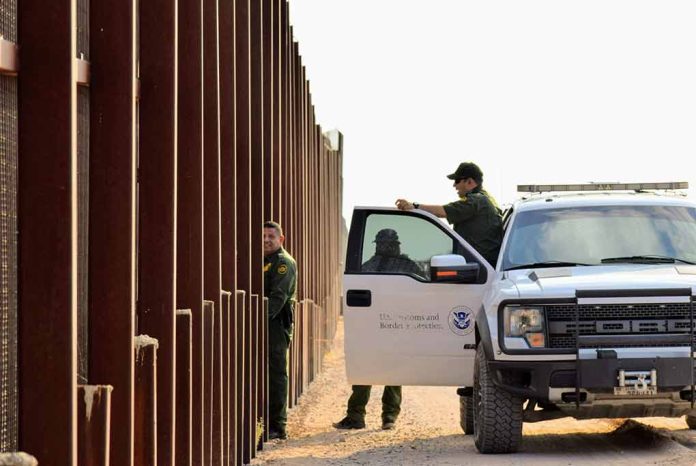
Border Patrol agents discovered a nearly 3,000-foot sophisticated drug smuggling tunnel connecting Tijuana to San Diego, complete with rail systems and ventilation – highlighting cartels’ increasingly desperate measures to bypass President Trump’s enhanced border security.
Key Takeaways
- U.S. Border Patrol uncovered an unfinished 2,918-foot narcotics smuggling tunnel extending from Tijuana to underneath the Otay Mesa Port of Entry, featuring advanced infrastructure including lighting, ventilation, and rail systems
- The tunnel’s entrance was cleverly concealed under freshly laid tile in a Nueva Tijuana home, while its planned exit aligned with a San Diego warehouse location
- This discovery marks one of more than 95 tunnels found in the San Diego area since 1993, suggesting cartels may be returning to underground methods as border security tightens
- Border officials plan to permanently seal the tunnel with thousands of pounds of concrete to prevent future use
Engineering Marvel of Cartel Smuggling
The tunnel discovered by U.S. Customs and Border Protection in early April represents a sophisticated feat of clandestine engineering. Stretching 2,918 feet from Tijuana, Mexico to San Diego, the underground passageway reached depths of 50 feet below ground level. Border Patrol agents found the tunnel equipped with electrical wiring, lighting systems, ventilation infrastructure, and a rail line designed specifically for moving narcotics across the international boundary. Despite its advanced construction, the tunnel was still incomplete when discovered, potentially preventing millions of dollars worth of drugs from reaching American streets.
The dimensions of the tunnel speak to its practical design for smuggling operations – measuring approximately 40 inches in height and 30 inches in width, large enough to move significant quantities of contraband but small enough to remain difficult to detect. Makeshift barricades had been strategically placed by tunnel workers in apparent attempts to slow Border Patrol agents’ progress and conceal the tunnel’s Mexican origin. These tactical elements highlight the calculated nature of this criminal infrastructure project and the resources dedicated to its construction.
Strategic Location Choice Reveals Cartel Tactics
The tunnel’s location in the Otay Mesa area was no coincidence. This region has become notorious for subterranean smuggling operations, with over 95 tunnels discovered and decommissioned since 1993. Mexican authorities, working on intelligence provided by U.S. officials, executed a search warrant that revealed the tunnel’s entrance hidden under freshly laid tile in a Nueva Tijuana home. The tunnel’s planned exit point was strategically aligned with a commercial warehouse space in San Diego, providing convenient cover for moving large quantities of narcotics into U.S. distribution networks.
U.S. Border Patrol agents say they uncovered and disabled a large-scale drug smuggling tunnel leading to San Diego from Tijuana. And, raising a flag to celebrate Juneteenth. Plus: The Hotel Del Coronado's 6-year, $550 million makeover is complete. https://t.co/DYxYWjfIto
— NBC 7 San Diego (@nbcsandiego) June 19, 2025
“The type of soil, the urban noise, traffic in the area, we have a port of entry where not only vehicles cross daily, thousands of them, pedestrians, and also trucks cross to the U.S.,” said Victor Clark, Human Rights Defense Committee in Tijuana Director
Border security experts note that this area presents ideal conditions for tunneling operations. The natural soil composition provides structural stability for underground construction, while the constant urban noise and heavy traffic at the nearby port of entry mask sounds of excavation and construction. Additionally, the proximity to major transportation infrastructure facilitates quick distribution once contraband successfully crosses the border – demonstrating the strategic calculus behind cartel operations that exploit every geographical advantage to penetrate America’s defenses.
Shifting Tactics Under Enhanced Border Security
The discovery of this elaborate tunnel may signal a tactical shift by drug trafficking organizations facing increased pressure at traditional border crossing points. Drug Enforcement Administration officials suggest that cartels could be returning to tunnel-based smuggling as enhanced screening measures at ports of entry make conventional smuggling more difficult. This adaptation represents a significant investment, as experts estimate that constructing such sophisticated tunnels can cost between one and four million dollars – reflecting the enormous profit potential that drives these criminal enterprises.
“As we continue to strengthen the nation’s air and maritime border security, it’s not surprising that foreign terrorist organizations would resort to underground routes. Disruption of narcotics smuggling tunnels is critical to protecting American lives,” said Jeffrey D. Stalnaker, Acting Chief Patrol Agent of the San Diego Sector
Border Patrol’s plans to fill the tunnel with thousands of pounds of concrete underscore the seriousness with which authorities view this threat. The permanent sealing of these underground pathways represents just one component of the ongoing battle against criminal organizations seeking to exploit any vulnerability in America’s border defenses. While tunnels may be less common now than in their heyday of the early 2000s, this discovery demonstrates that cartels remain willing to invest significant resources in bypassing President Trump’s enhanced border security measures highlighting the critical importance of vigilance and continued investment in border protection technology and personnel.














